NRAO eNews
Volume Vol#, Issue Iss#
Day# Month# Year#
NRAO eNews
Volume Vol#, Issue Iss# • Day# Month# Year#

Upcoming Events

The Past, Present, and Future of the VLA: Celebrating 40 Years
Aug 4 - 7, 2021 | Virtual
Student Funding Opportunity for ALMA Archival Research
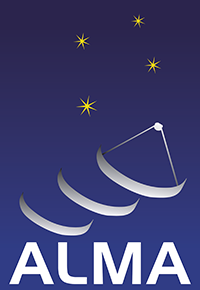
The North American ALMA Science Center is pleased to announce a funding opportunity to support students working on data obtained from the ALMA archive. This opportunity will follow the terms and conditions of the NRAO Student Observing Support (SOS) program. Students enrolled at U.S. universities and colleges are eligible for funding. Eligible expenses include a student stipend, computing hardware, and student travel to present ALMA results at a domestic conference. Awards are subject to the SOS cap of $35,000 per investigator per year, combined from any active VLA/VLBA and ALMA SOS awards. While preference will be given to programs that draw from the rich archive of public ALMA data, Principal Investigators (PIs) may also apply for funding to continue research on their own ALMA programs.
The NRAO SOS Program provides student funding on a competitive basis. Applications will consist of: (1) a scientific justification to describe the context, aims, and anticipated scientific results of the investigation, written using the ALMA dual-anonymous guidelines; (2) a statement of the student's role in the research and a plan for publication; and (3) a statement of the PI's current and pending funding and demonstrated need. The PI will also provide a description of the budget.
Visit the SOS website for more information and to apply. The application deadline is 7 May 2021. We expect to announce results in late June 2021.
Questions about this SOS opportunity may be directed to Jim Braatz.
ALMA Program News
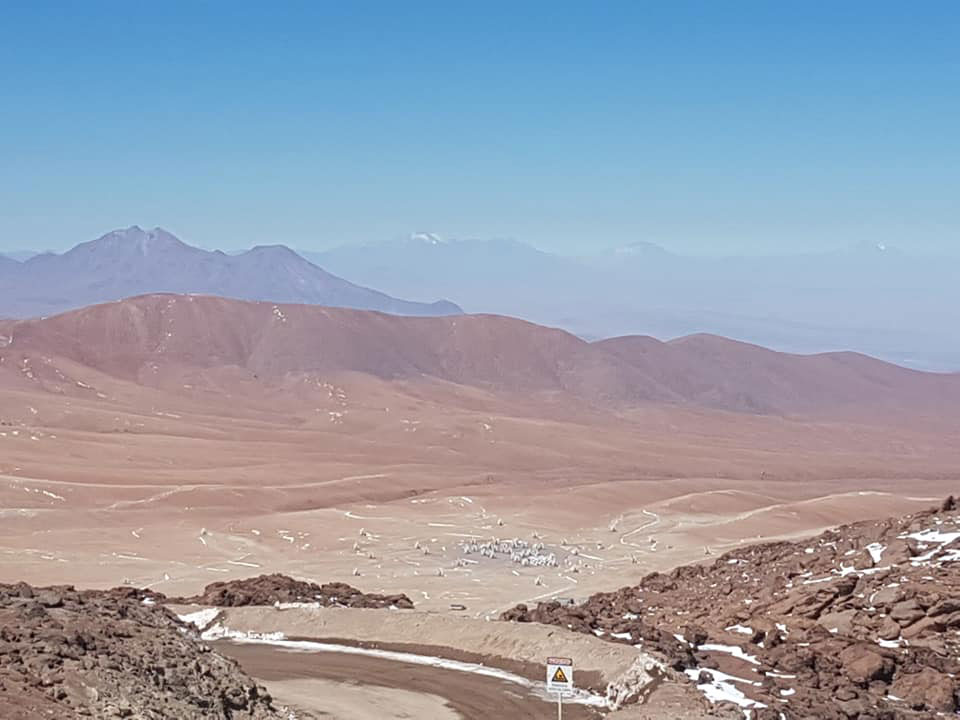
Sean Dougherty
ALMA seen from the Cerro Chajnantor summit (5640m), where the Tokyo Atacama Observatory is under construction, the highest construction site in Chile.
[click to enlarge]
ALMA Science Sustainability
The Cycle 9 Call for North American (NA) Development Project Proposals was announced 15 January 2021. An Informational Meeting was held 16 February, for which presentations are available and questions asked appear on the FAQ page. Notices of Intent were required before 1 March 2021; several were received. The deadline for receiving the proposals will be 9 April 2021. Shortly afterward they will be sent for review to teams of experts. On the basis of those reviews, recommendations will be made to NRAO and to NSF for consideration for the ALMA2030 Upgrade Program. Project execution can only begin after adjudication at the November 2021 ALMA Board Meeting. See NADevelopmentProgram.
Joint ALMA Observatory Observations Resumed
ALMA Science observations re-started on 17 March 2021. These were the first Cycle 7 data to be acquired since the Observatory shutdown, due to the Covid-19 pandemic, in March 2020. The first newly-acquired datasets have been calibrated and imaged, and have successfully passed the ALMA quality assurance stages. They will shortly be delivered to our users worldwide. At present, science observations are being taken on the 12-m Array only, in Bands 3-7 only. Up to forty-four 12m antennas have been available to science. Science observations will start on the 7-m Array when eight 7-m antennas are available.
ALMA Cycle 8 2021 is Open for Proposals
The Joint ALMA Observatory (JAO) will start the next cycle of observations, referred to as "Cycle 8 2021", in October 2021. A Call for Proposals with detailed information on Cycle 8 2021 was issued 17 March 2021 and the deadline for proposal submission is 21 April 2021.
Radio Recombination Lines from Protostellar Jets with the ngVLA
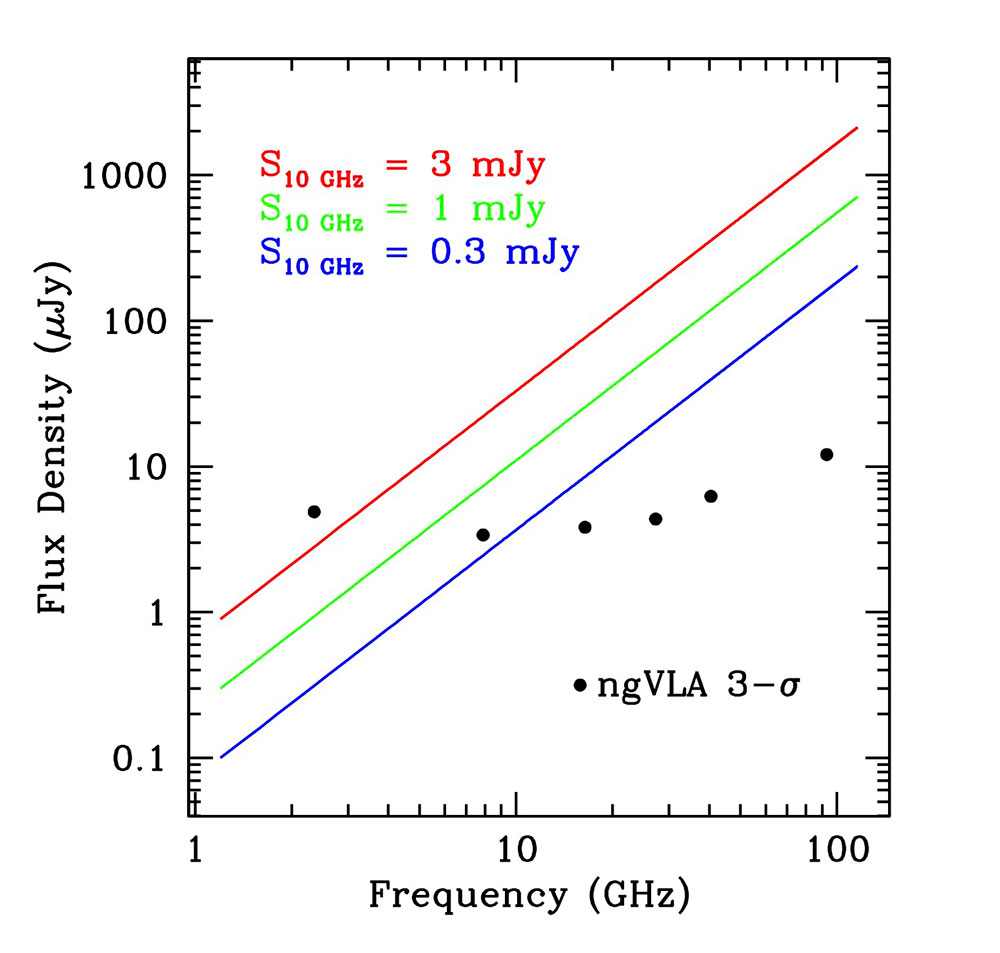
Lines indicate the expected peak flux density of RRLs from jets that have 10 GHz free-free continuum flux densities of 3 (red), 1 (green) and 0.3 (blue) mJy. Dots indicate the 3σ sensitivity in each ngVLA band for an on-source integration time of 6 hours, a velocity resolution of 50 km/s, and RRL stacking.
[click to enlarge]
Radio recombination lines (RRLs) have been an important tool to study HII regions and planetary nebulae. When the sources are obscured, the radio data may be the only way to study the morphology, kinematics, and other parameters of the ionized gas. RRLs are, however, relatively weak. At 10 GHz, a hydrogen recombination line, such as H86ɑ, will have a peak flux density of only 10% of the adjacent continuum free-free emission. Furthermore, while the signal-to-noise ratio (SNR) of the continuum measurements can be improved by using wider bandwidths, for the spectral lines we are limited to the small frequency width of the line emission.
Improving the line detection requires: (1) a larger collecting area, (2) better receivers, and (3) the possibility of stacking many lines of similar nature. The next generation Very Large Array (ngVLA) will offer superior capabilities in all three aspects. The larger collecting area and improved receivers will offer an order-of-magnitude sensitivity beyond the VLA. Furthermore, the very large widths of the ngVLA bands will enable stacking many RRLs to gain in SNR as the square root of the number of lines. ngVLA band 5 (30.5-50.5 GHz), e.g., accommodates 9 RRLs, H59ɑ to H51ɑ.
One source type that emits RRLs is the thermal jet that, together with a protoplanetary disk, characterizes the early stages of star formation. While the free-free continuum is easily detected with the VLA and similar interferometers, the RRLs have only a handful of possible detections (Jiménez-Serra et al. 2011, 2013; Guzmán et al. 2016). In combination with the observed proper motions, the RRLs will offer a 3-D picture of the jet motions. Two pressing issues will be studied for the first time on scales comparable to 1 AU: How are jets accelerated and collimated, and do the jets carry angular momentum from the disk detectable as small-scale rotation?
Following Anglada et al. (2018), we plot (see figure) the expected peak flux density for RRLs from jets with different values of the free-free flux densities at 10 GHz (solid color lines), as compared with the 3σ sensitivity that the ngVLA will achieve in each band (black dots). The RRLs are assumed to be in local thermal equilibrium, and to have an electron temperature of 104 K, a line width at half maximum of 200 km/s, and an ionized helium to ionized hydrogen number ratio of 0.1. All RRLs in the respective band are assumed to be stacked to improve the SNR.
From the figure, we can see that in the three higher frequency ngVLA bands it is expected to reach SNRs ~ 20 – 300. This will allow one to place several pixels across the jet and study its characteristics as a function of position. This figure gives the impression that the higher the observing frequency, the better. However, at 100+ GHz the dust emission will become dominant and dust opacity issues will arise. One also expects an increasing number of molecular lines that may contaminate the weak RRLs. It is possible that in practice the best observing compromise is bands 4 and 5.
Since 2015 the acronym ngVLA has appeared in 650+ publications indexed in the SAO/NASA Astrophysics Data System. This article continues a regular feature intended to highlight some of those publications. We are especially interested in showcasing work done by early-career researchers. Anyone wishing to volunteer to author a feature should contact Joan Wrobel.
The VLBA Flux Density Scale at 2cm
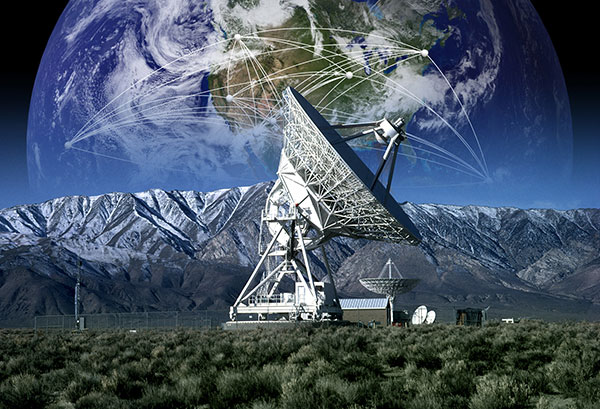
On 31 December 2020, the Principal Investigator (PI) of the 2cm blazar-monitoring "MOJAVE" project, Matt Lister, notified NRAO that his team had noticed a systematic ~10% decrease in the flux densities of their sources relative to monitoring being carried out using the Owens Valley Radio Observatory (OVRO) 40m telescope, starting sometime in the first half of 2019. Since all sources observable using the Very Long Baseline Array (VLBA) are variable, the simultaneous OVRO data provided a unique independent resource with which to compare VLBA data.
Many aspects of the VLBA online system have changed in the last two years, as part of moving away from obsolete computing hardware at each of the VLBA stations. To track down the source of the flux density discrepancy, NRAO staff spent the early part of 2021 re-verifying gain curves, focus, system temperature measurements, system equivalent flux densities, and antenna efficiencies. No significant problems or changes were identified. Two other items were notable regarding the VLBA and the MOJAVE project in 2019, however. First, the VLBA exhibited poor pointing in the first half of 2019, when some software updates were made associated with the new online system. Second, the MOJAVE project moved from using the Polyphase Filterbank (PFB) sampler mode to the Digital Downconverter (DDC) mode in September of that year.
The pointing problems were addressed such that the pointing at 3mm worked well for the Global 3mm VLBI Array (GMVA) session in April 2020. A VLBA memo is being prepared describing the possible impact of the pointing on VLBA data in 2019.
A test to evaluate the PFB vs. DDC sampler modes at 2cm was carried out in March 2021. This test showed that at 2cm the DDC appears to give ~12% lower flux densities than the PFB, for observations of the same source. While this is nominally within the stated uncertainties of VLBA flux densities, the systematic nature of the discrepancy is concerning, and NRAO staff are following up to understand the source of the discrepancy and the extent to which this discrepancy affects VLBA flux densities at 2cm and other bands.
Updates on this topic will be posted in the VLBA news feed and the VLBA memo series.
At this time, we welcome independent reports of problems with the VLBA flux density scale from the user community, to help diagnose the extent of data affected by the problems reported here. Please submit comments or questions about the VLBA flux density scale through the NRAO helpdesk.
Call for FAST Science Observing Proposals

The Five-hundred-meter Aperture Spherical radio Telescope (FAST), a Chinese national science facility, welcomes submission of science proposals for the upcoming observing period scheduled from August 2021 to July 2022. Users of any nationalities or affiliations are invited to submit proposals before the deadline at
16:00 UT on 15th May 2021
through the website http://fast.bao.ac.cn/proposal_submit. Information on the techniques and current performance of the telescope are available at http://fast.bao.ac.cn.
The FAST science operation covers both regular science programs and large programs. Please note that this Call only solicits regular science proposals, which usually take observing time no more than 100 hours. It is anticipated that about 1800 hours of observing time will be allocated to regular science programs. All proposals should make it clear why the FAST is necessary for the requested observations.
The FAST started its full operation in January 2020, and is now completing its first science observing period. A list of previously accepted science proposals, including both regular science and large programs, can be found at http://fast.bao.ac.cn. Note that information of future approved proposals, including titles, PI names, abstracts, and scheduling priorities, will also be posted at the website. Science data obtained through a regular science program have a proprietary period of 12 months. Please see the FAST Data Policy posted at http://fast.bao.ac.cn for more details. Proposers should query the FAST archive before planning observations to check if any existing data meet their scientific goals.
Should you have any further questions about the telescope operation and proposal submission, please contact us at fast-proposal-support@nao.cas.cn.
ALMA News Manager & Public Information Officer
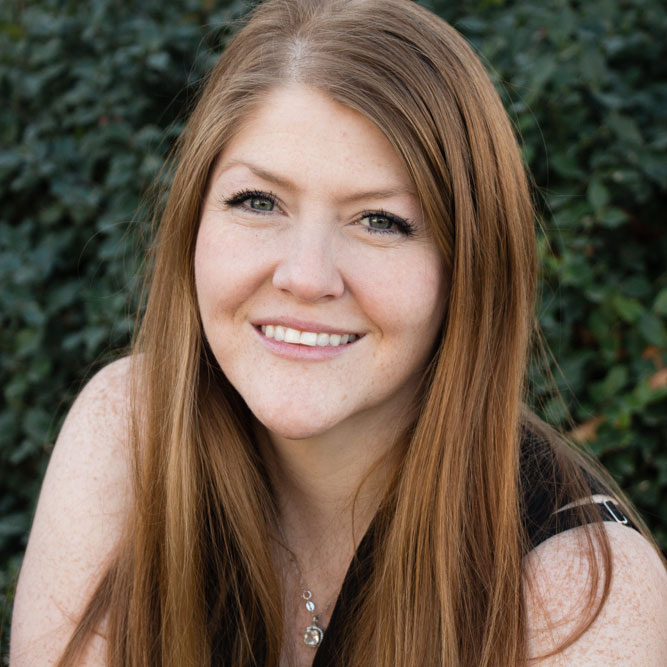
Amy Oliver
[click to enlarge]
Amy Oliver has joined the NRAO Education & Public Outreach team as the News Manager and Public Information Officer for the Atacama Large Millimeter/submillimeter Array (ALMA). Prior to joining ALMA, Oliver has produced communications covering numerous observatories and telescope systems, including the Event Horizon Telescope, Very Energetic Radiation Imaging Telescope Array System, Cherenkov Telescope Array, Submillimeter Array, South Pole Telescope, Hubble Space Telescope, Green Bank Observatory, MMT Observatory, Very Large Telescope, Keck Observatory, Magellan, and more. She has worked directly in astrochemistry, theoretical physics, and computational physics. In 2021, Oliver was elected as a Fellow of the Royal Astronomical Society for her contributions to science communication and dark skies advocacy.
Prior to astrophysics, Oliver worked in science and technology communications covering satellite, space, and mobile technologies, including Ka and Ku-band, microwave radio frequencies, artificial intelligence, the Radio Access Network, and edge computing.
Outside of work, she is a contributing science writer to Earth/Sky and is a NASA/JPL Solar System Ambassador, where she creates accessible gateways to science learning and NASA missions through informal education experiences, and leads the Spanish subgroup.
If you are an astronomer with new ALMA science results that may be press worthy, please contact Amy at aoliver@nrao.edu or +1-434-242-9584 to discuss our press release process.
Recent Media Releases
|
New Images Reveal Magnetic Structures Near Supermassive Black Hole |
|
|
IMAGE RELEASE: Cosmic Lens Reveals Faint Radio Galaxy |
From the Archives
Ellen Bouton

[click to enlarge]
About this month's photo: Seventy years ago, on 25 March 1951, Harold "Doc" Ewen, working with his Harvard thesis advisor, Edward Purcell, made the first observation of HI, neutral interstellar hydrogen, predicted but never before detected. Ewen, as his thesis project, used a horn antenna jutting out of the window of the Lyman Lab at Harvard. In this photo, taken at the dedication of the Harvard 60-foot antenna in 1956, Ewen (left) and Purcell (right) stand under the 60-foot antenna and beside the horn antenna used for the HI detection, which now sits outside the Jansky Lab at the Green Bank Observatory. Read Ewen's account of the detection.
From the Archives is an ongoing series illustrating NRAO and U.S. radio astronomy history via images selected from our collections of individuals' and institutional papers. If readers have images they believe would be of interest to the Archives, please contact Ellen Bouton.

